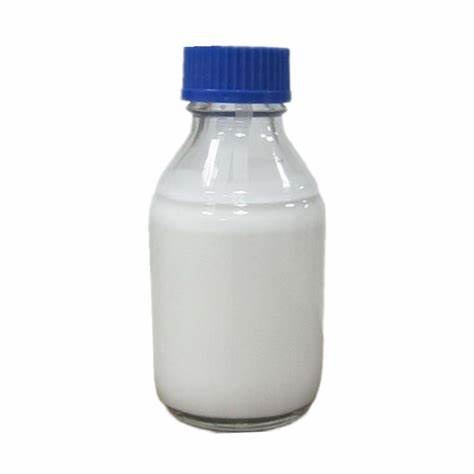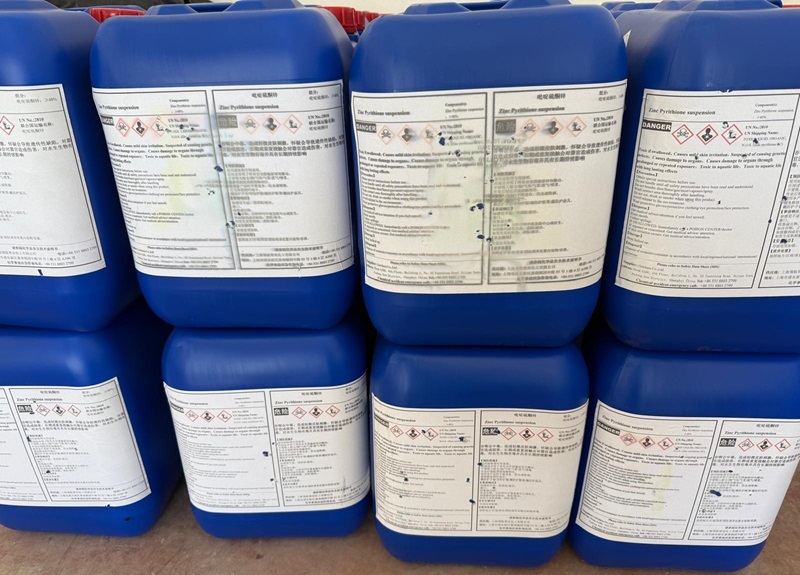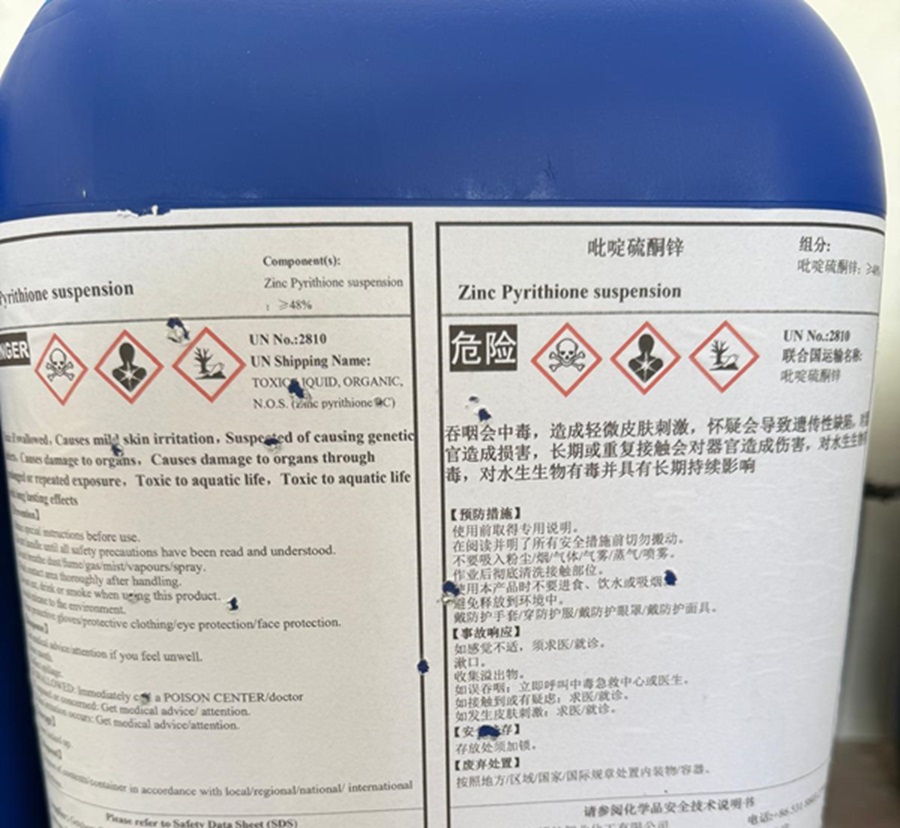We unleash your business potential by maximize the business innovation.
Send EmailZINC PYRITHIONE, Zinc Omadine, Zinc Polyanemine, Pyrithione Zincique, ZPT, 13463-41-7
🧪 Zinc Pyrithione – Technical Profile
Chemical Name: Zinc Pyrithione Synonyms:
-
Zinc Omadine
-
ZPT
-
Pyrithione Zinc
-
Zinc Polyanemine
-
Pyrithione Zincique
-
Bis[(pyridine-1-oxide)-2-yl]thio]zinc
-
CAS Number: 13463-41-7
-
Molecular Formula: C₁₀H₈N₂O₂S₂Zn
-
Molar Mass: 317.7 g/mol
-
Appearance: White to yellow crystalline powder
-
Odor: Mild, characteristic
-
Melting Point: ~240 °C (decomposes)
-
Density: 1.78 g/cm³
-
Solubility:
-
Water: Very low (8 ppm at pH 7)
-
Ethanol: ~100 mg/kg
-
PEG-400: ~2000 mg/kg
-
pH Range: Optimal between 4.5–9.5
🧫 Functional Properties
-
Fungistatic: Inhibits fungal cell division
-
Bacteriostatic: Prevents bacterial proliferation
-
Broad-Spectrum Antimicrobial: Effective against Streptococcus, Staphylococcus, Malassezia spp.
-
Algaecide: Used in marine coatings to prevent biofouling
🏭 Industrial Applications
| Sector | Use Case |
|---|---|
| Cosmetics | Anti-dandruff shampoos, scalp treatments, skin creams |
| Pharmaceuticals | Topical antifungal agents, eczema and psoriasis treatments |
| Paints & Coatings | Mildew-resistant outdoor paints, marine antifouling coatings |
| Adhesives | Preservative in water-based adhesives |
| Water Treatment | Biocide in closed-loop systems and cooling towers |
| Pesticides | Low-toxicity fungicide and bactericide for agricultural formulations |
⚠️ Safety & Regulatory
-
GHS Classification:
-
Signal Word: Danger
-
Hazard Statements: H301 (Toxic if swallowed), H318 (Eye damage), H330 (Fatal if inhaled), H410 (Very toxic to aquatic life)
-
-
UN Code: UN 2811 – Toxic substances
-
WGK (Germany): 3 – Severe water hazard
-
FDA / EU Use: Previously allowed in cosmetics; now restricted in some regions due to toxicity concerns
-
REACH: Subject to authorization in EU (as of 2022)
📦 Packaging & Storage
-
Packaging: HDPE drums or foil-lined bags (25 kg)
-
Storage: Cool, dry, well-ventilated area; protect from light and oxidizers
-
Shelf Life: 24 months under recommended conditions
🧴 Zinc Pyrithione (ZPT) – Detailed Usage Overview
1. Cosmetics & Personal Care
-
Shampoos (Anti-Dandruff): ZPT is widely used as an active ingredient in anti-dandruff shampoos due to its antifungal action against Malassezia species. Typical concentration ranges from 0.3% to 2%. It helps reduce scalp flaking, itching, and microbial imbalance.
-
Skin Creams & Lotions: Used in formulations targeting seborrheic dermatitis, eczema, and acne. Its antimicrobial properties help reduce inflammation and skin irritation.
-
Liquid Soaps & Cleansers: Acts as an antibacterial agent in hygiene products, especially in hand soaps and body washes.
2. Paints & Coatings
-
Exterior Wall Paints: Prevents mold, mildew, and algae growth on painted surfaces. It inhibits biofilm formation, extending surface cleanliness and durability.
-
Marine Coatings: Used in antifouling paints to prevent microbial adhesion on submerged surfaces such as ship hulls.
-
Wood & Metal Finishes: Provides antimicrobial protection in humid environments, enhancing product longevity.
3. Textile & Fiber Processing
-
Antimicrobial Finishing: Applied to fabrics to inhibit bacterial growth, especially in medical textiles, sportswear, and undergarments.
-
Dye Bath Additive: Helps prevent microbial contamination during dyeing processes.
4. Water Treatment & Industrial Hygiene
-
Closed-Loop Systems: Used as a biocide in cooling towers, HVAC systems, and industrial water circuits to prevent biofilm formation.
-
CIP Cleaning Systems: Added to cleaning solutions in food and pharmaceutical facilities for microbial control.
5. Plastics & Polymers
-
Antimicrobial Masterbatch: Incorporated into PVC, PE, and PP polymers to prevent microbial growth. Common in medical packaging, kitchenware, and hygienic surfaces.
6. Agrochemicals
-
Fungicide Co-Active: Used in crop protection formulations to inhibit fungal growth on leaves and stems. Enhances adhesion and surface coverage.
-
Soil & Greenhouse Applications: Helps regulate microbial balance and suppress pathogenic organisms.
7. Veterinary & Pet Care
-
Pet Shampoos: Acts as an antifungal agent for treating skin infections in animals.
-
Topical Sprays & Lotions: Used in formulations for skin health and microbial control in pets.
✅ Zinc Pyrithione (ZPT) – Compatibility Table
| 🧪 Component | 🔄 Compatibility | ⚠️ Notes |
|---|---|---|
| 💧 Water (Aqueous Systems) | ⚠️ Limited | Low solubility; use as suspension |
| 🧼 Anionic Surfactants | ✅ Compatible | Ideal for shampoos and soaps |
| 🧴 Nonionic Surfactants | ⚠️ Caution | May reduce efficacy due to chelation |
| 🧪 Chelators (EDTA, etc.) | ❌ Incompatible | Forms complexes; deactivates ZPT |
| 🧈 Oil Phase (Creams/Lotions) | ✅ Compatible | Stable in emulsions and oil-based systems |
| 🌿 Botanical Extracts | ✅ Compatible | Suitable for natural formulations |
| 🧬 Proteins & Peptides | ⚠️ pH-sensitive | Requires pH control to avoid precipitation |
| 🧪 Organic Acids (Citric, etc.) | ⚠️ pH-dependent | Stability decreases below pH 4 |
| 🧪 Preservatives (Phenoxyethanol) | ✅ Compatible | Supports antimicrobial systems |
| 🧪 Polymers (Carbomer, HPMC) | ✅ Compatible | Stable in gels, creams, and suspensions |
Zinc pyrithione
1-hydroxypyridine-2-thione zinc
CAS: 13463-41-7
Molecular Formula: C10H8N2O2S2Zn
Names and Identifiers
| Name | 1-hydroxypyridine-2-thione zinc |
| Synonyms | ZPT Zinc Omadine Omadine Zinc Pyrithione Zinc ZINC PYRITHIONE zincpolyanemine Pyrithione zincique zinc 2-pyridinethiol-1-oxide Mercaptopyridinenoxidezincsalt 1-HYDROXYPYRIDINE-2-THIONE ZINC 1-hydroxypyridine-2-thione zinc 2-Mercaptopyridine N-oxide zinc salt 1-HYDROXY-2-PYRIDINE THIONE, ZN SALT zinc bis(2-thioxopyridin-1(2H)-olate) zinc bis(pyridine-2-thiol) di-1-oxide zinc bis(pyridine-2-thiolate 1-oxide) Bis[(1-oxylatopyridinium-2-yl)thio]zinc Bis[(1-oxylatopyridinium)-2-ylthio] zinc Bis[[(pyridine 1-oxide)-2-yl]thio] zinc salt zinc bis(1,2-dihydro-2-thioxo-1-pyridyl) dioxide Bis(2-pyridylthio) Zinc 1,1'-Dioxide1-Hydroxypyridine-2-thione Zinc Salt2-Pyridinethiol 1-Oxide Zinc SaltZinc Pyrithione |
| CAS | 13463-41-7 |
| EINECS | 236-671-3 |
| InChI | InChI=1/2C5H4NOS.Zn/c2*7-6-4-2-1-3-5(6)8;/h2*1-4H;/q2*-1;+2 |
| InChIKey | OTPSWLRZXRHDNX-UHFFFAOYSA-L |
Physico-chemical Properties
| Molecular Formula | C10H8N2O2S2Zn |
| Molar Mass | 317.7 |
| Density | 1.782 g/cm3(Temp: 25 °C) |
| Melting Point | approximate 240℃ |
| Boling Point | 253.8°C at 760 mmHg |
| Flash Point | 107.3°C |
| Water Solubility | Insoluble ( |
| Solubility | almost transparency in Pyridine |
| Vapor Presure | 0Pa at 25℃ |
| Appearance | Light brown particles |
| Color | White to Orange to Green |
| Merck | 14,7994 |
| Storage Condition | Sealed in dry,Room Temperature |
| MDL | MFCD00067336 |
| Physical and Chemical Properties |
water-soluble Insoluble (<0.1g/100 mL at 21°C), off-white powder |
| Use | In cosmetics as anti-dandruff agents and fungicides, widely used in the preparation of anti-dandruff shampoo. Mainly used in cosmetics, shampoo, skin care, but also for adhesives, coatings, paints and so on. |
Risk and Safety
| Risk Codes | R24/25 - R26 - Very Toxic by inhalation R37/38 - Irritating to respiratory system and skin. R41 - Risk of serious damage to eyes R50/53 - Very toxic to aquatic organisms, may cause long-term adverse effects in the aquatic environment. R23 - Toxic by inhalation R22 - Harmful if swallowed |
| Safety Description | S26 - In case of contact with eyes, rinse immediately with plenty of water and seek medical advice. S28 - After contact with skin, wash immediately with plenty of soap-suds. S36/37/39 - Wear suitable protective clothing, gloves and eye/face protection. S45 - In case of accident or if you feel unwell, seek medical advice immediately (show the label whenever possible.) S61 - Avoid release to the environment. Refer to special instructions / safety data sheets. S60 - This material and its container must be disposed of as hazardous waste. S39 - Wear eye / face protection. |
| UN IDs | UN 2811 6.1/PG 2 |
| WGK Germany | 3 |
| RTECS | ZH0950000 |
| HS Code | 29333990 |
| Hazard Class | 6.1(b) |
| Packing Group | III |
| Toxicity | LD50 oral in rat: 177mg/kg |
Reference Information
| LogP | 0.9 at 25℃ and pH7.5-7.7 |
| surface tension | 73mN/m at 7.22mg/L and 20 ℃ |
| product description | zinc pyrithione is also known as zinc pyrithione, zinc pyrithione, and zinc omedine. this zinc complex was synthesized as early as 2030s and used as an antifungal or antibacterial agent for external use. White to yellow crystalline powder at room temperature. Slightly characteristic smell. Insoluble in water. Zinc pyrithione forms insoluble precipitates with cationic and nonionic surfactants, which are unstable to light and oxidants, and unstable to acids and bases at higher temperatures. It is not compatible with EDTA, and non-ionic surfactants will partially inactivate it. In the presence of heavy metals, chelation or dechelation will occur, and these chelates are hardly soluble in water. EEC and GB7916-87 stipulate that the maximum allowable concentration mass fraction of zinc pyrithione in cosmetics is 0.5%, which is only used in products cleaned after use. For a period of use, the concentration of 250~1000 mg/kg (active substance) can be used for gel, cream, emulsion, powder and dandruff shampoo, as well as for deodorization and disinfection products. |
| traits | zinc pyrithione is a white non-precipitating emulsion. |
| use | zinc pyrithione is used for shampoo dandruff, which can inhibit the growth of gram-positive and negative bacteria and mold. Can effectively care for hair, delay hair aging, control the generation of white hair and hair loss. Zinc pyrithione ZPT has a strong killing power on fungi and bacteria, and can effectively kill dandruff-producing fungi and play a role in dandruff removal. As a long-standing dandruff remover, zinc pyrithione ZPT is widely known in the shampoo industry and used by many well-known brands. Zinc pyrithione ZPT is also used as a cosmetic preservation agent, oil, pulp, paint, fungicide, and is also widely used. It has strong killing power to fungi and bacteria, and can effectively kill dandruff-producing fungi and play a role in removing dandruff. As an anti-dandruff agent and fungicide in cosmetics, it is widely used to prepare dandruff shampoo. Mainly used for cosmetics, shampoo, skin care, can also be used for adhesives, coatings, paints, etc. personal care products; used as anti-dandruff agents and fungicides in cosmetics, widely used to prepare dandruff shampoo used for dandruff shampoo, can inhibit the growth of gram-positive and negative bacteria and mold. Can effectively care for hair, delay hair aging, control the generation of white hair and hair loss. In addition, it is also used as a cosmetic preservation agent, oil agent, paint biocide; as a fungicide for coatings and plastics and other products, it is also widely used. Broad-spectrum fungicides and pollution-free marine biocides |
| CAS Number | 13463-41-7 |
| Chem/IUPAC Name: | Pyridine-2-thiol-1-oxide, zinc complex (2:1) |
| EINECS/ELINCS No: | 236-671-3 |
| COSING REF No: | 38974 |
Zinc Pyrithione is a compound commonly used in cosmetics and personal care products for its antifungal and antibacterial properties. It is an active ingredient designed to treat dandruff, seborrheic dermatitis, and various fungal infections of the skin and scalp. Zinc Pyrithione works by inhibiting the growth of fungi and bacteria that contribute to these conditions, helping to reduce flakiness, itching, and irritation. Additionally, it aids in controlling sebum production, contributing to a healthier scalp environment. The chemical formula of Zinc Pyrithione is C10H8N2O2S2Zn.
What is ZINC PYRITHIONE used for?
Zinc Pyrithione is a beneficial compound owing to its antimicrobial properties and finds extensive application in personal care products and cosmetics. Primarily utilized in cleansing formulations like shampoos and soap, this ingredient effectively targets dandruff, seborrheic dermatitis, and fungal skin infections by inhibiting the growth of fungi and bacteria responsible for these conditions. It also alleviates symptoms like itching, flaking, and redness on the scalp and skin. Zinc Pyrithione’s ability to regulate microbial balance and control sebum production makes it an essential ingredient in products designed to promote scalp and skin health, offering consumers relief from common dermatological issues with proven efficacy.
Origin
Zinc Pyrithione is synthesized through a multistep chemical process. Initially, 2-mercaptopyridine-N-oxide reacts with sodium hydroxide to form sodium pyrithione. This compound undergoes a double displacement reaction with zinc sulfate, yielding Zinc Pyrithione precipitate. The product is then filtered, washed, and dried to obtain a fine powder.
What does ZINC PYRITHIONE do in a formulation?
- Antidandruff
- Antimicrobial
- Hair conditioning
- Preservative
Safety profile
While generally safe for topical use, Zinc Pyrithione may cause mild side effects such as skin irritation, redness, or dryness, especially in individuals with sensitive skin. Prolonged or excessive use can exacerbate these symptoms. Additionally, some people may experience allergic reactions characterized by itching or swelling. It is advisable to perform a patch test before widespread application and discontinue use if adverse reactions occur.
ZINC PYRITHIONE Alternatives
KETOCONAZOLE, SELENIUM SULFIDE
Technical profile
| Property | Values |
| Boiling Point | 350.20°C |
| Melting Point | 240°C |
| Solubility | Soluble in water |
| Viscosity | Low to moderate |



